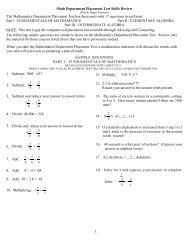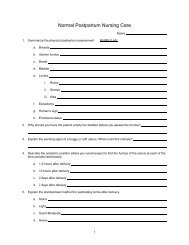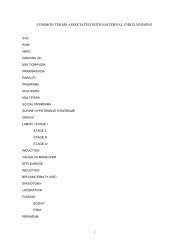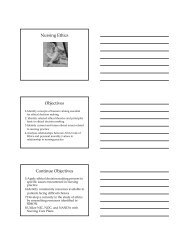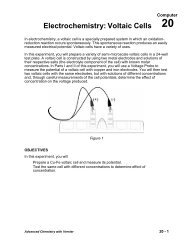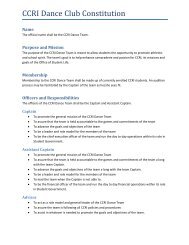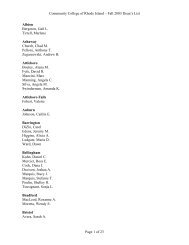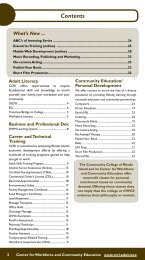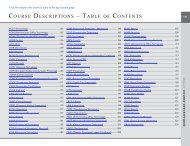Course Descriptions - Community College of Rhode Island
Course Descriptions - Community College of Rhode Island
Course Descriptions - Community College of Rhode Island
You also want an ePaper? Increase the reach of your titles
YUMPU automatically turns print PDFs into web optimized ePapers that Google loves.
in the making <strong>of</strong> studio projects. Classes<br />
include lectures, demonstrations, studio<br />
assignments and critiques. Studio Lecture: 4<br />
hours<br />
ARTS 1500 - Fine Art Seminar -<br />
3 Credits<br />
Fine Art Seminar is the keystone course in<br />
which AFA students learn to set and pursue<br />
pr<strong>of</strong>essional goals including: transferring to<br />
four-year art programs, exploring careers<br />
in art and design, designing and installing<br />
exhibitions, identifying visual arts grants and<br />
awards, and developing a cohesive portfolio<br />
<strong>of</strong> their work which demonstrates their<br />
level <strong>of</strong> excellence. Fine Art Seminar topics<br />
may include portfolio preparation, choosing<br />
an art school, photographing artwork and<br />
exploring careers in the arts. Students participate<br />
in a pr<strong>of</strong>essional group exhibition,<br />
held once a year. This course is designed<br />
for art majors or for students considering a<br />
major in art. (Prerequisites: At least two studio<br />
courses and one art history course or permission<br />
<strong>of</strong> the instructor. Recommended: Students<br />
should be concurrently enrolled in studio and/<br />
or art history courses. Class should be taken<br />
during the third semester <strong>of</strong> the student’s program<br />
<strong>of</strong> study.)<br />
ARTS 1510 - Art History: Ancient to<br />
Medieval - 3 Credits<br />
This course is a survey <strong>of</strong> visual art from<br />
prehistory through Gothic Europe. Emphasis<br />
is placed on how art, architecture and<br />
functional objects provide evidence <strong>of</strong> the<br />
religious beliefs and cultural structures <strong>of</strong><br />
early civilizations. Regions covered include<br />
Egypt, the Near East and Europe. (Prerequisite:<br />
ENGL 1005 or 1010 with a grade <strong>of</strong> “C”<br />
or better) Lecture: 3 hours<br />
ARTS 1520 - Art History: Renaissance<br />
to Modern - 3 Credits<br />
This course is a survey <strong>of</strong> visual art and<br />
architecture from the Renaissance through<br />
the 20th century, focused primarily upon<br />
European and American study. The manner<br />
in which art both reflects and shapes<br />
history is a central means <strong>of</strong> exploration,<br />
leading to the complexities <strong>of</strong> art in the<br />
Post-Modern period. (Recommended: ARTS<br />
1510; Prerequisite: ENGL 1005 or 1010 with<br />
a grade <strong>of</strong> “C” or better) Lecture: 3 hours<br />
ARTS 1530 - Art History: Non-Western<br />
Topics - 3 Credits<br />
This seminar-style course analyzes art<br />
outside <strong>of</strong> Europe and America through<br />
focused studies <strong>of</strong> world cultures, providing<br />
a depth <strong>of</strong> understanding rather than<br />
a comprehensive survey. Creative expressions<br />
in Africa, Asia, the Americas and<br />
the Pacific <strong>Island</strong>s are the landscape <strong>of</strong><br />
investigation. Through weekly readings and<br />
writing exercises; lecture, discussion and<br />
film; online research and visits to museums<br />
and galleries, this class builds a vision <strong>of</strong> the<br />
world seen through diverse cultural traditions.<br />
(Prerequisite: ENGL 1005 or 1010 with<br />
a grade <strong>of</strong> “C” or better) Lecture: 3 hours<br />
ARTS 1610 - Textile Design/Fibers -<br />
3 Credits<br />
This studio course is designed to introduce<br />
students to a variety <strong>of</strong> dyeing and surface<br />
design techniques on fabric, with an emphasis<br />
on learning the elements and principles<br />
<strong>of</strong> two-dimensional design. Techniques may<br />
include shibori tie-dye, batik wax-resist,<br />
paste-resist, blockprinting and photo transfer.<br />
Traditional and contemporary examples<br />
<strong>of</strong> these processes are presented and good<br />
craftsmanship is emphasized. This course is<br />
recommended for all art majors and can<br />
serve as an introductory art course for<br />
all students. (Recommended: ARTS 1010 or<br />
1020 or 1310) Studio: 4 hours<br />
ARTS 1630 - Introduction to Sculpture<br />
and Form - 3 Credits<br />
Concept development and structural<br />
problem-solving are emphasized in this<br />
advanced study <strong>of</strong> three-dimensional<br />
design. Examples <strong>of</strong> form in nature,<br />
sculpture and architecture as well as current<br />
approaches to sculpture using basic<br />
materials and techniques are practiced and<br />
discussed. Classes include demonstrations,<br />
studio assignments, critiques and lectures.<br />
(Note: Cannot be taken in same semester as<br />
ARTS 1410) Studio: 4 hours<br />
ARTS 1650 - Ceramics I - 3 Credits<br />
This course acts as an introduction to fine<br />
art ceramics. Coil, slab and other basic<br />
hand-building methods as well as glazing<br />
and various kiln firing methods are covered.<br />
Kiln and basic glazes are provided; clay and<br />
tools must be purchased. (Recommended:<br />
ARTS 1410) Studio: 4 hours<br />
ARTS 1660 - Ceramics II - 3 Credits<br />
This is a continuation <strong>of</strong> fine arts ceramics<br />
using advanced hand-building techniques.<br />
Wheel throwing, glaze formulation, kiln<br />
management and alternative firing methods<br />
are introduced. Kiln and basic glazes are<br />
provided; clay and tools must be purchased.<br />
(Prerequisite: ARTS 1650 or permission <strong>of</strong><br />
instructor) Studio: 4 hours<br />
ARTS 1710 - Graphic Design I -<br />
3 Credits<br />
This course provides an introduction to<br />
the basic principles <strong>of</strong> graphic design and<br />
visual communication. Graphic representation<br />
and typographic fundamentals are<br />
explored with electronic and traditional<br />
media, tools, skills and methodology. A history<br />
<strong>of</strong> graphic communication is presented<br />
through example and slide presentation.<br />
(Prerequisite: none, although ARTS 1310 is<br />
recommended) Studio: 4 hours<br />
ARTS 1720 - Graphic Design II -<br />
3 Credits<br />
This course continues coverage <strong>of</strong> concepts<br />
introduced in Graphic Design I. Focus is<br />
on creative image making and typographic<br />
development in a variety <strong>of</strong> visual formats.<br />
Projects provide experience with elements<br />
<strong>of</strong> print and/or digital publication design,<br />
Prerequisite: Successful completion <strong>of</strong> course required before registering. Corequisite: <strong>Course</strong> must be taken prior to or at the same time.<br />
arts<br />
logo design, poster design and the design<br />
<strong>of</strong> visual systems. (Prerequisite: ARTS 1710 or<br />
permission <strong>of</strong> instructor) Studio: 4 hours<br />
ARTS 1810 - Photography I - 3 Credits<br />
This course emphasizes the creative and<br />
expressive aspects <strong>of</strong> form and content<br />
in black-and-white photographic imagery.<br />
<strong>Course</strong> content includes the operation <strong>of</strong> a<br />
camera, film development and printing and<br />
may include alternative and contemporary<br />
processes. A 35 mm camera with adjustable<br />
controls, film, paper and developing<br />
equipment are required. (Supplies - excluding<br />
camera - average approximately $300.)<br />
(Prerequisite: None, although ARTS 1010 or<br />
ARTS 1310 is recommended) Studio: 4 hours<br />
ARTS 1820 - Photography II - 3 Credits<br />
This course refines basic photographic<br />
techniques and introduces material such<br />
as photographic lighting, archival processes,<br />
toning, exposure, developmental controls<br />
and alternative and contemporary processes.<br />
The history, styles and critical theory<br />
<strong>of</strong> photography are presented through<br />
lectures, reading, gallery visits and studio<br />
assignments. Students develop portfolios<br />
focusing on presentation, sequencing and<br />
multiple images. (Prerequisite: ARTS 1810 or<br />
permission <strong>of</strong> instructor) Studio: 4 hours<br />
ARTS 1840 - Digital Art I - 3 Credits<br />
This course explores creative and technical<br />
issues related to computer-based image<br />
making as an effective means <strong>of</strong> artistic<br />
expression. While students apply the fundamentals<br />
using the latest industry-standard<br />
digital photo editing s<strong>of</strong>tware, they also<br />
acquire both the manual and conceptual<br />
skills associated with creativity in the digital<br />
realm. Projects provide experience with<br />
image manipulation, montage, color corrections,<br />
retouching, and layout and design <strong>of</strong><br />
individual artist’s projects. Studio: 4 hours.<br />
145



